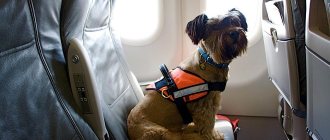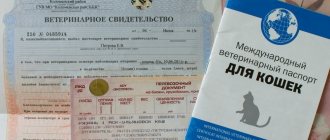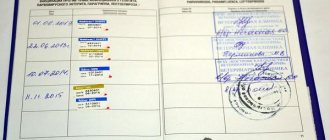Why does a dog need a veterinary passport?
A dog must have a veterinary passport, regardless of whether it is purebred or not, participates in exhibitions or is only a companion. This document is required in the following cases:
- when exporting an animal abroad;
- when transporting a dog on public transport;
- if you are planning a long trip with your pet across Russia;
- when visiting and participating in exhibitions, sports competitions and other public events;
- to participate in breeding;
- when registering a hunting license, if the dog is planned to participate in the hunt;
- in case of loss, theft, or killing of an animal, the veterinary passport serves as one of the proofs that the animal belongs to the rightful owner;
- The document allows you to track the timing of vaccination, deworming, and treatment against ectoparasites.
Of course, when traveling to the dacha by personal transport, it is unlikely that traffic police officers will ask you to show documents for your pet, but transporting an animal on an airplane or long-distance train, without accompanying documents, which are issued on the basis of a veterinary passport, is impossible. The only exceptions are guide dogs.
When transporting an animal abroad, customs will not study the entire document; usually customs officers only look at a photo of the dog and vaccination marks against rabies and leptospirosis.
Microchipping a cat
A good method that will prove that the cat is yours and no one else’s is microchipping. To do this, an electronic chip or simply a carrier is sewn under your pet’s skin. However, this technique is mainly used by owners of purebred animal species. This is a kind of electronic passport, which can be used to restore all data if suddenly the paper form is lost or something happens to it.
Mostly owners of purebred animal species resort to microchipping.
But keep in mind that chipping itself is an expensive pleasure and not everyone can afford it. Typically, the cost of such a procedure ranges from 600 to 1500 rubles.
Where to get a veterinary passport for a dog
When purchasing a purebred puppy from a nursery or from a breeder with a good reputation, a veterinary passport is already included in the set of documents that is given to the buyer along with the puppy. The document is drawn up by the breeder himself when the first vaccination is carried out.
Otherwise, a veterinary passport for a dog can be purchased at any state veterinary service. A veterinary passport is an official document, so you should not purchase it from private veterinary clinics if there is no information about the licensing of their veterinary activities.
You should review the veterinary passport, since they are issued by various companies, the pages may contain advertising information or other useless information.
Requirements for flea products
The best solution would be to contact a veterinarian, who will select a parasite remedy appropriate to the age and health of the cat, as well as the degree of flea damage. But if this option is not possible, and it is necessary to carry out antiparasitic treatment of the animal as early as possible, you should focus on the following selection criteria.
Efficiency.
How effective a remedy against parasites will be depends on the active components included in its composition. Unfortunately, you can independently determine the effectiveness of shampoo or drops on the withers only experimentally, which carries a certain risk. Therefore, when choosing a flea remedy, you should first consult with a veterinary pharmacy employee or seek help from an online store or online pharmacy.
Safety.
The names of the active substances contained in the flea remedy may not be clear to a non-specialist. But some of these components require special dosage accuracy, since they are highly toxic, and some products are generally contraindicated for cats or are not used in sick, weak, young, lactating, etc. animals. In this case, it is important to purchase the product only at specialized points of sale and choose products intended for use in cats. Before using a spray, shampoo, etc., read the instructions for the product, make sure that it is not contraindicated for your pet, and use the product exactly as recommended.
Convenience.
Anti-parasite shampoo is perfect for a cat accustomed to water treatments. It will not only get rid of fleas, but will also remove dirt from the fur and skin. But if the animal is categorically against bathing, you need to choose a different form of antiparasitic drugs - drops on the withers, a collar, a spray.
Speed of onset of effect.
For a cat that has accidentally become infected with parasites while walking or traveling, it is better to choose drops on the withers. They cause the death of existing parasites within a few days and protect the cat from re-infection for a long time. But if an animal is seriously infested with fleas, every minute brings suffering. In this case, you need to use an anti-parasitic shampoo or spray, and only after removing the fleas should you think about a remedy to protect your pet from re-infection.
A special case is a cat that is not walking and suddenly has fleas on it. This means that a breeding ground for fleas is somewhere in the house, and they got into your apartment on your shoes or entered on their own. Mass migrations of fleas usually occur when city services poison rodents. In this case, you will have to treat not only the cat, but the entire apartment, and, if necessary, also the entrance, attic or basement. It is better to contact the official pest control authorities or write a complaint to the management company. Treating the animal will only bring temporary relief, and fleas can begin to bite people.
How to fill out an international veterinary passport for a dog
This document is a small book with numbered sheets reserved for specific information.
The sections on the first pages are filled out by the breeder, dog owner or veterinarian. Enter information about the owner (full name, residential address, contact details) and about the dog (name, breed, gender, date of birth, color, special features, identification data). The gender of the animal is marked with a tick rather than written in letters. Next to the gender selection boxes there is a box to tick if the dog is spayed or neutered. Identification information includes a barcode sticker if the pet has a chip implanted, the date of implantation and the area where the chip is placed.
On the first page of the spread, a photograph of the animal is pasted in, preferably in full height (standing side view) and with the veterinarian’s seal. If the puppy is still small, then pasting in the photo should be postponed until the puppy is 1 year old. A hunting breed dog must be photographed full length on the left side.
The international veterinary passport has a page for filling in information about the breeder. The name and surname of the breeder, his full residential address and contact information should be indicated. A separate page is provided for the stamps of the veterinary institution and the doctor’s signature.
The following pages are marked with tables in which notes are made on vaccinations against rabies, plague, hepatitis, leptospirosis, enteritis and other vaccinations. The cells of the tables are filled out by a veterinarian, who enters the date of vaccination, pastes a sticker with information about the vaccine, signs and seals. Without stickers, seals and signatures, as well as vaccination certificates certified by unauthorized bodies, are considered invalid.
Vaccination data
The following is a section with notes on rabies vaccination. Each mark contains a date, type of vaccine (sticker), a stamp with the vaccine batch number, a veterinarian’s signature, and a clinic seal.
The section on basic vaccination contains information on vaccinations against panleukopenia, rhinotracheitis and calcivirosis, and is completed in the same way as the previous section.
In special sections on deworming and treatment for fleas and ticks, marks are made and drug stickers are pasted. This can be done either by the owner himself or by the doctor.
How to choose a veterinary passport?
Depending on what kind of animal you have, purchase the appropriate passport. The passports themselves are universal; they can be created for cats, dogs and other animals. There are passports for cats and dogs, most of them are international, in such a passport the columns are duplicated in English, I came across passports where English and Finnish were present. In any case, the difference between an international veterinary passport is that it has a translation into English; with such a passport, your pet will easily pass veterinary control in any country in the world.
Where can I get a veterinary passport?
Veterinary passports (forms) are freely sold in pet stores and veterinary pharmacies, clinics and offices. In addition, a passport is issued either by the breeder when you buy a kitten or puppy, or it will be given to you by a veterinarian after your pet has been vaccinated.
Place of receipt and registration rules
A dog has a hot nose: causes and what to do
The passport is issued by a veterinarian at a state clinic. A blank form can be purchased locally and immediately given to a specialist to fill out the information. It is better to check on the spot how much this service will cost.
Sample of a blank international passport
Typically, a veterinary passport is obtained when the puppy is first vaccinated. After the procedure, a record of vaccination is added to the document. Therefore, most often the breeder receives a passport.
New passports are more convenient to use. In addition to information about medical treatments, they provide additional fields for notes and repetition of section names in international English.
Note! Any entry must be certified by the signature of a veterinarian and the seal of the medical institution, otherwise the data will not be included when passing control at the border. The seal of the kennel club is not enough to confirm the information.
How to fill out a veterinary passport correctly.
Filling out a veterinary passport for a dog or cat is not at all difficult. Most of the entries are made by a veterinarian; the owner fills out only a few fields.
Pets photo
I think everything is clear here. You can take a photo of your cat or dog and paste the resulting photo into your passport; no stamps are required, and filling out this field is at the request of the owner.
Description of the animal / Main information
Pets name
Filled out in accordance with the card or metric received from the breeder/kennel, if the animal is purebred, if not - arbitrarily.
Here, too, we indicate the breed as in the metric; for “ordinary” cats and dogs we write the word “Mestis”.
Date of birth
We indicate the exact date if there is a metric; if not, we write an approximate one.
Gender in animals is written as male and female, not male and female. You can indicate the gender as “cat”, “cat”, “male” and “bitch”, but the latter looks like a curse word, so it’s better to be a female or you can draw “shield and spear of Mars” or “mirror of Venus”, for those who have artistic abilities.
Either we write off the metrics or think for ourselves. For white and black animals everything is simple, we write “white” or “black”. There are also more complex options, for example, “tortoiseshell” or “black and tan”; here the easiest way is to look on the Internet for photographs of the colors of six cats and dogs and their names, then select the one you want and write it down in your passport.
Distinguishing marks
Usually these are some color features, for example, a white spot behind the ear, “socks” on the front legs. In this field, describe your pet's distinctive feature, if any.
Animal card number
Pedigree number
We take these numbers from the document received from the breeder or nursery; if not, we leave empty fields.
Tatoo (tag) number
This applies more to dogs, if puppies get a tattoo with the number of the kennel, this number is an identifier, and it is indicated in the passport. Recently, the stigma has become less and less common; instead, dogs and cats are microchipped.
This is where the owner completes filling out data about the animal, such fields as
Identification number
Information about animal registration / Pets Registration
To be completed by a veterinarian.
Information about the pet owner is also filled in independently. There is nothing complicated, we write the last name, first name and patronymic, address and telephone number.
The fields are filled in by the breeder; if not, leave them blank.
All other fields will be filled out by the veterinarian.
Registration date
The second page is reserved for notes on the registration of the animal at the veterinary clinic, which are made within 1 month from the date of purchase of adult animals, and puppies and kittens upon reaching 3 (2) months of age.
Re-registration is carried out after 1 year from the date of registration and then no later than 2 months from the date of expiration. Remember that re-registration notes must be made by a veterinarian - all of them are accompanied by the doctor’s signature and the clinic’s stamp with the license number.
Subtleties and nuances of how to fill out an international veterinary passport for dogs and cats
The owner needs to fill out an international veterinary passport for dogs not only in connection with traveling abroad, but also to visit exhibitions and transport the pet within the country. A standard document contains detailed information about the owner (full name, address, contact information) and the animal (name, date of birth, breed, brand, special features, etc.), vaccinations and deworming (begin filling out at 2-2, 5 months, after a year a photo is pasted).
Describing the pet
What is included in the description of a cat? The international veterinary passport for cats must contain the following information:
- The cat's nickname (the pet's name must correspond to what is indicated in the metric or pedigree - for purebred animals, if the cat is not purebred - you can write the nickname at your discretion);
- Ident. number (stamp for dogs);
- Pedigree number;
- Date of birth (also indicated by metric or pedigree. If you do not know exactly when your pet was born, write the approximate date and month);
- Gender (in this column you need to put a tick in the box F (female - female) or M (male - male). Sometimes special icons are used to indicate gender. If your passport contains the “Neuter” box, put a tick there if your the animal is sterilized);
- Breed (we copy the name of the breed from the pedigree or metric. For “nobles” we write “mixed breed”);
- Coat color (we again copy the color from the official documents of purebred cats - this can be a name or a coding. For pets of common blood, you can simply write “red”, “black with white spots”, “gray tabby”);
- Type of coat and markings / Special features.
When filling out this column, we choose from four options: hairless, shorthaired, semi-longhaired or longhaired. Special features may include “extra” fingers, torn ears, missing eyes, spots or stripes that are not typical for the breed.
How to fill out an international veterinary passport for dogs
It is not difficult to fill out an international veterinary passport for dogs yourself; to do this, you need to carefully and legibly enter the required information in the appropriate columns of the document. Sections that indicate veterinary treatments (deworming, vaccination, etc.) are filled out in a veterinary clinic and certified by the signature and seal of a specialist.
Why do you need a veterinary passport for a dog?
The owner needs a veterinary passport for a dog in the following situations:
- For hassle-free travel in any public transport - taxis, buses, trains, planes, etc.
- In cases where it is necessary to prove ownership of a pet.
- When crossing the external borders of the country (leaving for permanent residence, on vacation, on a business trip, to an exhibition, etc.).
- Participation in various exhibition events associated with the presence of other animals.
- In order to track antiparasitic treatments and vaccination schedule.
- Participation in the work of breeding and improving breed qualities.
Example of a completed passport
According to current legislation, the owner of an animal is not required to present a veterinary passport when traveling with a pet within the country . However, experienced dog breeders recommend taking this document with you on a trip to avoid unpleasant situations.
How to get a passport for a dog
The owner can obtain a passport for a dog by contacting a veterinary clinic. This issue is often dealt with by the breeder from whom the puppy is purchased. At the age of 2-2.5 months, a note is placed in the document about deworming and the first vaccination of the pet. You can purchase dog metrics not only at a specialized institution, but also at a pet store.
And here is more information about the rules for transporting a dog in a car.
What does a dog's passport, international vaccination certificate look like?
A dog's passport looks like a small book in which the pages are divided into columns and lines. In the international document, names in Russian are duplicated in English. On the first page of the metric there is a place for pasting a photograph of the pet and lines in which data about the owner is entered - last name, first name, patronymic, place of residence, contact information. The international document contains a column that reflects information about the breeder.
As for data about the animal, the veterinary passport must indicate the name, date of birth, and breed. The document contains lines that include the animal’s gender, information about castration, color, and special features. After the dog turns 1 year old, a photograph is pasted into the document.
Separate columns in the metric contain data that allows you to identify a pet - brand, pedigree number, information about the microchip. As for information about microchipping, this section includes information about the date of the procedure and its location. A barcode is attached to the page, which confirms the fact of microchipping and completely replicates the data of the microchip implanted in the pet’s body.
The International Vaccination Certificate contains information regarding veterinary treatments performed. The document indicates the dates and drugs used for deworming before vaccination. On specially designated pages, information about the routine vaccination is entered - the date of vaccination, the name, series and number of the vaccine, the signature of a veterinary specialist and the seal of the institution where the procedure was carried out.
Watch this video on how to fill out an international passport for a dog:
Gender of the dog in the passport: how to indicate
To indicate the gender of the dog in the passport, you must select a Latin designation: the male gender (male) is designated in veterinary metrics by the letter M (male), and the female gender (bitch) by the letter F (female). As a rule, in the document, the gender is marked with a tick in the box opposite the letter M or F. In addition to the gender, information about the castration (sterilization) of the animal is also entered.
Information about the pet’s gender, like other data, is entered into the document in legible handwriting and block letters.
Is data on deworming treatment included in the puppy passport?
The puppy passport, which is filled out by the breeder, contains information about deworming. Such data is necessary for a veterinarian to plan the first vaccinations and create a schedule for subsequent treatments. Information about the date of the antiparasitic procedure and the name of the drug is entered in the appropriate columns.
How long is a dog passport valid?
A dog passport is issued for an animal once and is valid for the entire life of the pet. An international document has no expiration date and, if lost, is subject to mandatory restoration.
Where to get a dog passport
You can get a dog passport at a pet store, a specialized clinic, or from a breeder. However, without the appropriate marks, signatures and seals, the metric will not be valid.
How much does it cost to get a passport for a dog?
Making a dog passport is inexpensive - the book itself with the necessary pages costs from 50 to 150 rubles, depending on the quality of the cover and design. Notes on deworming and vaccination are provided by a veterinarian free of charge.
What should be specified
The cat's passport must contain the following information:
- Last name, first name and patronymic of the owner;
- Address (street, city, country).
Your full name should be written down as in your own passport. An actual address is preferable (this will make it easier to find you if necessary), and if possible, it is better to indicate both your place of residence and your place of registration.
Phone - first of all, mobile, but again it is better to write down all the numbers that you can call.
As for the photo of the pet, it should be in color, no larger than 5.5 by 8 centimeters in size and show the whole cat, not just the face.
Is it necessary to obtain passports for animals?
It is mandatory to obtain a pet passport in cases where the pet crosses the border of the country. Without this document, executed accordingly, neither a cat nor a dog will be allowed through veterinary control at customs.
If you do not plan to travel abroad, then it is not necessary to issue an international document, but the animal must have a veterinary passport. Its presence will allow you to freely travel within the country, attend exhibitions and other events.
Document appearance
In Russia, a veterinary passport for a cat does not have one set form and can be different. The basis here is not the appearance, but its internal content. However, there is an exception in certain regions of the country. For example, in St. Petersburg, strict veterinary rules have been established. The passport you can make there will look exactly like this:
In Russia, a veterinary passport for a cat does not have one set form and can be different.
Keep in mind that it will be difficult to get abroad with this document, since there is no place for a photograph of the pet, and the columns are printed only in Russian and English. This is a very serious reason to refuse your travel abroad.
Before you get a passport for your cat, thoroughly study all the rules for exporting an animal, as well as the region in which you will be drawing up the document.
How to make a passport for a dog or cat if the previous one is lost
A veterinarian will help you get a passport for your dog or cat if the document is lost. To do this, the owner must contact a specialized institution where the pet was vaccinated. Based on the accounts, the animal’s veterinary passport will be restored. This procedure is free. The owner will only have to pay for the purchase of the booklet itself.
And here is more information about how to transport a cat on a train.
The veterinary passport of a dog or cat is the main document required for transporting animals by public transport. Without it, veterinary customs control will not give permission to cross the border. The document of the established form must contain the necessary notes on vaccinations against rabies and other infectious diseases. If you lose your passport, you can restore it by contacting a veterinary institution.
Veterinarian's tasks
- write down information about the animal in the remaining blank fields;
- install and register the chip;
- enter data on vaccination against rabies, vaccinations against various infections and preventive treatment of the cat;
- make notes on the clinical examination;
- schedule the next vaccination.
The specialist certifies all entries in the document with a signature and personal seal.
It is important to know! A veterinary passport is considered official only when it bears the registration and stamp of the clinic.
Friends, thank you for reading my article and I hope you benefited from it.
Write your reviews and questions in the comments.
I wish you and your mustachioed pets good health. See you!
Source











